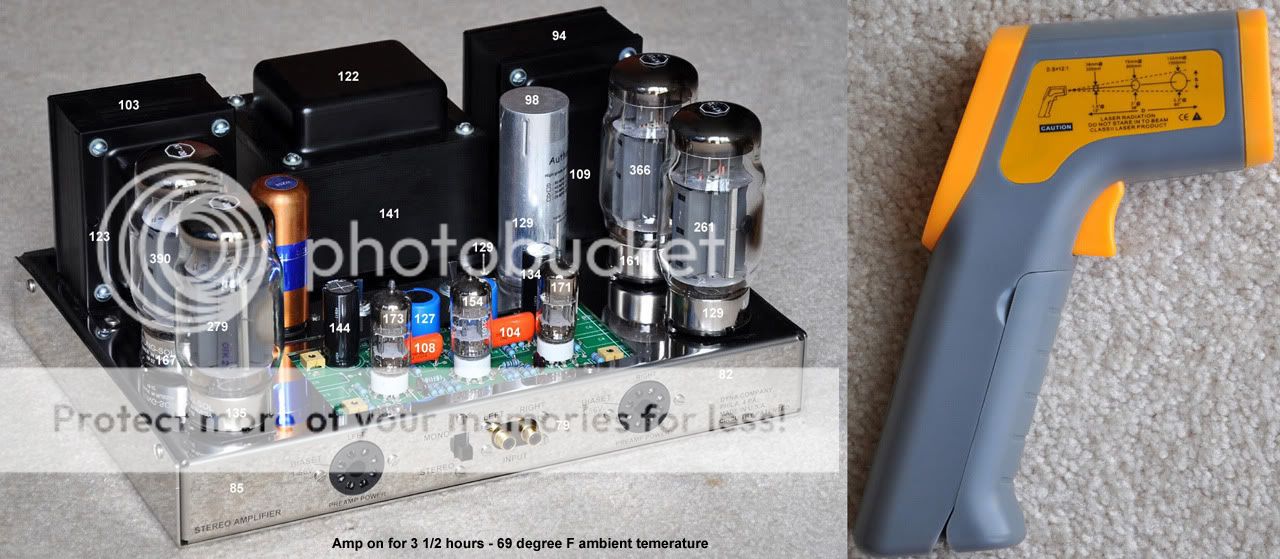I found this interesting would this work on a st-120 vta?
http://cgi.ebay.com/Harman-Kardon-Citation-II-Stereo-Tube-Amplifier-Carver-/180685645498?pt=Vintage_Electronics_R2&hash=item2a11b426ba
Remarkable New Tube
Several months ago the new Tung-Sol KT120 vacuum tubes became available, and I just had to try them! I found them to be remarkable - , great tubes with distortion, bandwidth, and fidelity as good as anything I have ever experienced. In order to obtain the best from these remarkable new tubes it was necessary to modify the turns ratio of the output transformer by a factor of 1.414. This lowered the impedance and optimally matched the new tubes, and I didn’t even have to alter the transformer design or change the wires inside; all I had to do was connect the external wires up in a new way such that the effective driving point impedance was optimized for these tubes.
http://contact.ebay.com/ws/eBayISAPI.dll?ShowAllQuestions&ShowASQAlways=1&frm=284&iid=180685645498&ssPageName=PageAskSellerQuestion_VI&redirect=0&requested=audioshopper
Q: How can you get that power at 30 hz with that iron that was at best 60 watts at that freq....And the power supply transformer with the doubler circuit was already at the limit of power. Plaease post this question and your answer . Jun-24-11
A: Hi 'di, It's easy. Here goes, I begin. Any transformer low frequency limit is defined by the volt-time product that may be delivered to the primary winding without saturation. Since I did not change the B+ voltage one iota (It was and is 455 volts DC),and the time it takes for a 20 Hz tone to traverse one cycle remains the same (0.050 seconds) before and after the update, the volt-time product remains the same. This means the transformer low frquency limit has not changed at all. The Citation II output transformer is among the best in the world, and I was jealous of it for a long time. I could not match it at first, it having been designed by the genius Stu Hegeman. The stock transformer has a power bandwith that is well below twenty Hz, around 15 Hz or so. So how DID The output go up without running into a low frequency limit? The KT-120 tubes can pull the top of the transformer winding down about 30 volts more than the KT88 tubes. This yields slightly more output volts on the secondary winding, and by defining the taps (the ones already on the transformer) differently, we can double the power. At least in theory. The 16 ohm tap becomes the eight ohm tap, the eight ohm tap becomes the four ohm tap, and so on. And because the taps are now spaced 2-4-8 instead of 4-8-16, we get 1.414 more output volts than before. Output power is proportional to the square of the voltage, and since 1.414 squared is two, we get twice the power. Note that the secondary is completely out of the equation (except for the rms voltage output). That's just the way transformers work. At first it might seem we get something for nothing, so what's the catch? Believe it or not, there is none. The only potential difficulty is that the output tubes will see a reduced impedance and "bog" down when asked to deliver twice the power. And in fact, the KT88's DO bog severely, whereas KT120's deliver the power easily. Thanks for a GREAT question, Bob Carver.



